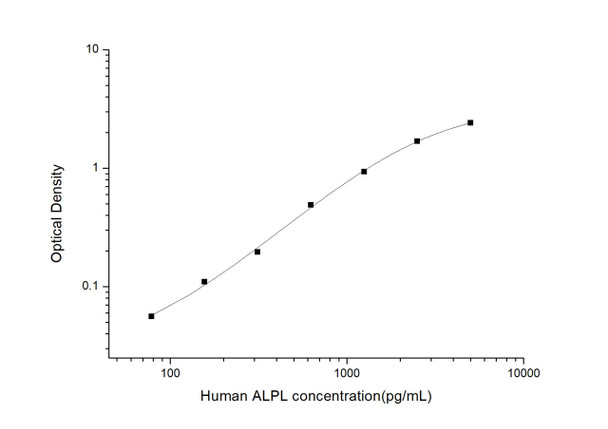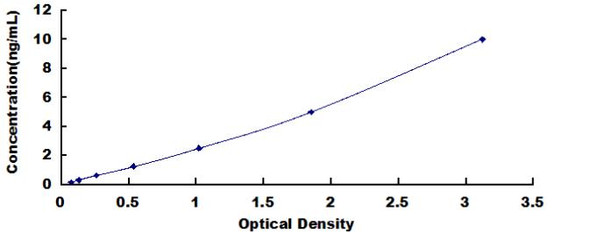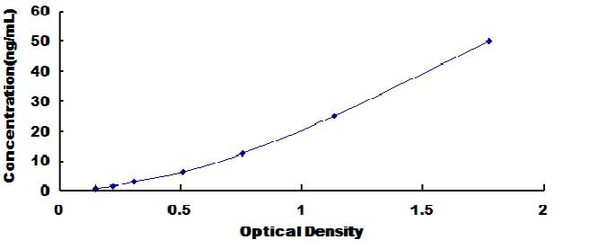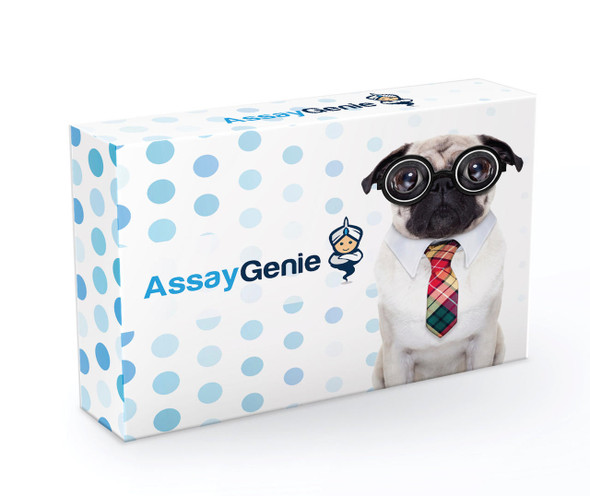Human Signal Transduction ELISA Kits
Human ALPL(Alkaline Phosphatase,Liver/Bone/Kidney)ELISA Kit (HUES03390)
- SKU:
- HUES03390
- Product Type:
- ELISA Kit
- Size:
- 96 Assays
- Uniprot:
- P05186
- Sensitivity:
- 46.88pg/mL
- Range:
- 78.13-5000pg/mL
- ELISA Type:
- Sandwich
- Reactivity:
- Human
- Sample Type:
- Serum, plasma and other biological fluids
- Research Area:
- Signal Transduction
Description
| Assay type: | Sandwich |
| Format: | 96T |
| Assay time: | 4.5h |
| Reactivity: | Human |
| Detection Method: | Colormetric |
| Detection Range: | 78.13-5000 pg/mL |
| Sensitivity: | 46.88 pg/mL |
| Sample Volume Required Per Well: | 100µL |
| Sample Type: | Serum, plasma and other biological fluids |
| Specificity: | This kit recognizes Human ALPL in samples. No significant cross-reactivity or interference between Human ALPL and analogues was observed. |
This ELISA kit uses Sandwich-ELISA as the method. The micro ELISA plate provided in this kit has been pre-coated with an antibody specific to Human ALPL. Standards or samples are added to the appropriate micro ELISA plate wells and combined with the specific antibody. Then a biotinylated detection antibody specific for Human ALPL and Avidin-Horseradish Peroxidase (HRP) conjugate are added to each micro plate well successively and incubated. Free components are washed away. The substrate solution is added to each well. Only those wells that contain Human ALPL, biotinylated detection antibody and Avidin-HRP conjugate will appear blue in color. The enzyme-substrate reaction is terminated by adding Stop Solution and the color turns yellow. The optical density (OD) is measured spectrophotometrically at a wavelength of 450 nm ± 2 nm. The OD value is proportional to the concentration of Human ALPL. The concentration of Human ALPL in samples can be calculated by comparing the OD of the samples to the standard curve.
| UniProt Protein Function: | ALPL: This isozyme may play a role in skeletal mineralization. Defects in ALPL are a cause of hypophosphatasia (HOPS). HOPS is an inherited metabolic bone disease characterized by defective skeletal mineralization. Four hypophosphatasia forms are distinguished, depending on the age of onset: perinatal, infantile, childhood and adult type. The perinatal form is the most severe and is almost always fatal. Patients with only premature loss of deciduous teeth, but with no bone disease are regarded as having odontohypophosphatasia (odonto). Defects in ALPL are a cause of hypophosphatasia childhood type (HOPSC). Defects in ALPL are a cause of hypophosphatasia infantile type (HOPSI). Belongs to the alkaline phosphatase family. 3 isoforms of the human protein are produced by alternative splicing. |
| UniProt Protein Details: | Protein type:EC 3. 1. 3. 1; Cofactor and Vitamin Metabolism - folate biosynthesis; Membrane protein, GPI anchor; Motility/polarity/chemotaxis; Phosphatase (non-protein) Chromosomal Location of Human Ortholog: 1p36. 12 Cellular Component: extracellular matrix; extracellular space; membrane; integral to membrane; plasma membrane Molecular Function:protein binding; pyrophosphatase activity; alkaline phosphatase activity; metal ion binding Biological Process: osteoblast differentiation; response to antibiotic; response to vitamin D; dephosphorylation; response to glucocorticoid stimulus; reproductive developmental process; response to lipopolysaccharide; skeletal development; endochondral ossification Disease: Hypophosphatasia, Infantile; Hypophosphatasia, Adult; Hypophosphatasia, Childhood |
| NCBI Summary: | There are at least four distinct but related alkaline phosphatases: intestinal, placental, placental-like, and liver/bone/kidney (tissue non-specific). The first three are located together on chromosome 2, while the tissue non-specific form is located on chromosome 1. The product of this gene is a membrane bound glycosylated enzyme that is not expressed in any particular tissue and is, therefore, referred to as the tissue-nonspecific form of the enzyme. The exact physiological function of the alkaline phosphatases is not known. A proposed function of this form of the enzyme is matrix mineralization; however, mice that lack a functional form of this enzyme show normal skeletal development. This enzyme has been linked directly to hypophosphatasia, a disorder that is characterized by hypercalcemia and includes skeletal defects. The character of this disorder can vary, however, depending on the specific mutation since this determines age of onset and severity of symptoms. Alternatively spliced transcript variants have been described. [provided by RefSeq, Apr 2010] |
| UniProt Code: | P05186 |
| NCBI GenInfo Identifier: | 68067533 |
| NCBI Gene ID: | 249 |
| NCBI Accession: | P05186. 4 |
| UniProt Secondary Accession: | P05186,O75090, Q2TAI7, Q59EJ7, Q5BKZ5, Q5VTG5, Q6NZI8 Q8WU32, A1A4E7, B2RMP8, B7Z387, B7Z4Y6, |
| UniProt Related Accession: | P05186 |
| Molecular Weight: | 51,045 Da |
| NCBI Full Name: | Alkaline phosphatase, tissue-nonspecific isozyme |
| NCBI Synonym Full Names: | alkaline phosphatase, liver/bone/kidney |
| NCBI Official Symbol: | ALPL |
| NCBI Official Synonym Symbols: | HOPS; TNAP; APTNAP; TNSALP; AP-TNAP |
| NCBI Protein Information: | alkaline phosphatase, tissue-nonspecific isozyme; glycerophosphatase; tissue-nonspecific ALP; alkaline phosphomonoesterase; liver/bone/kidney-type alkaline phosphatase; alkaline phosphatase liver/bone/kidney isozyme |
| UniProt Protein Name: | Alkaline phosphatase, tissue-nonspecific isozyme |
| UniProt Synonym Protein Names: | Alkaline phosphatase liver/bone/kidney isozyme |
| Protein Family: | Alkaline phosphatase |
| UniProt Gene Name: | ALPL |
| UniProt Entry Name: | PPBT_HUMAN |
As the OD values of the standard curve may vary according to the conditions of the actual assay performance (e. g. operator, pipetting technique, washing technique or temperature effects), the operator should establish a standard curve for each test. Typical standard curve and data is provided below for reference only.
| Concentration (pg/mL) | O.D | Average | Corrected |
| 5000 | 2.455 2.469 | 2.462 | 2.404 |
| 2500 | 1.734 1.75 | 1.742 | 1.684 |
| 1250 | 1.006 0.98 | 0.993 | 0.935 |
| 625 | 0.543 0.551 | 0.547 | 0.489 |
| 312.5 | 0.258 0.25 | 0.254 | 0.196 |
| 156.25 | 0.174 0.162 | 0.168 | 0.11 |
| 78.13 | 0.106 0.122 | 0.114 | 0.056 |
| 0 | 0.056 0.06 | 0.058 | -- |
Precision
Intra-assay Precision (Precision within an assay): 3 samples with low, mid range and high level Human ALPL were tested 20 times on one plate, respectively.
Inter-assay Precision (Precision between assays): 3 samples with low, mid range and high level Human ALPL were tested on 3 different plates, 20 replicates in each plate.
| Intra-assay Precision | Inter-assay Precision | |||||
| Sample | 1 | 2 | 3 | 1 | 2 | 3 |
| n | 20 | 20 | 20 | 20 | 20 | 20 |
| Mean (pg/mL) | 232.41 | 686.93 | 2152.29 | 235.06 | 692.44 | 2121.00 |
| Standard deviation | 15.27 | 28.64 | 98.79 | 13.26 | 38.85 | 75.51 |
| C V (%) | 6.57 | 4.17 | 4.59 | 5.64 | 5.61 | 3.56 |
Recovery
The recovery of Human ALPL spiked at three different levels in samples throughout the range of the assay was evaluated in various matrices.
| Sample Type | Range (%) | Average Recovery (%) |
| Serum (n=5) | 96-110 | 102 |
| EDTA plasma (n=5) | 87-103 | 94 |
| Cell culture media (n=5) | 94-105 | 100 |
Linearity
Samples were spiked with high concentrations of Human ALPL and diluted with Reference Standard & Sample Diluent to produce samples with values within the range of the assay.
| Serum (n=5) | EDTA plasma (n=5) | Cell culture media (n=5) | ||
| 1:2 | Range (%) | 88-102 | 93-105 | 91-105 |
| Average (%) | 95 | 99 | 97 | |
| 1:4 | Range (%) | 88-102 | 83-93 | 85-98 |
| Average (%) | 94 | 89 | 91 | |
| 1:8 | Range (%) | 88-102 | 85-97 | 85-98 |
| Average (%) | 93 | 92 | 92 | |
| 1:16 | Range (%) | 92-107 | 80-90 | 87-102 |
| Average (%) | 99 | 86 | 93 |
An unopened kit can be stored at 4°C for 1 month. If the kit is not used within 1 month, store the items separately according to the following conditions once the kit is received.
| Item | Specifications | Storage |
| Micro ELISA Plate(Dismountable) | 8 wells ×12 strips | -20°C, 6 months |
| Reference Standard | 2 vials | |
| Concentrated Biotinylated Detection Ab (100×) | 1 vial, 120 µL | |
| Concentrated HRP Conjugate (100×) | 1 vial, 120 µL | -20°C(shading light), 6 months |
| Reference Standard & Sample Diluent | 1 vial, 20 mL | 4°C, 6 months |
| Biotinylated Detection Ab Diluent | 1 vial, 14 mL | |
| HRP Conjugate Diluent | 1 vial, 14 mL | |
| Concentrated Wash Buffer (25×) | 1 vial, 30 mL | |
| Substrate Reagent | 1 vial, 10 mL | 4°C(shading light) |
| Stop Solution | 1 vial, 10 mL | 4°C |
| Plate Sealer | 5 pieces | |
| Product Description | 1 copy | |
| Certificate of Analysis | 1 copy |
- Set standard, test sample and control (zero) wells on the pre-coated plate and record theirpositions. It is recommended to measure each standard and sample in duplicate. Note: addall solutions to the bottom of the plate wells while avoiding contact with the well walls. Ensuresolutions do not foam when adding to the wells.
- Aliquot 100µl of standard solutions into the standard wells.
- Add 100µl of Sample / Standard dilution buffer into the control (zero) well.
- Add 100µl of properly diluted sample (serum, plasma, tissue homogenates and otherbiological fluids) into test sample wells.
- Cover the plate with the sealer provided in the kit and incubate for 90 min at 37°C.
- Aspirate the liquid from each well, do not wash. Immediately add 100µL of BiotinylatedDetection Ab working solution to each well. Cover the plate with a plate seal and gently mix. Incubate for 1 hour at 37°C.
- Aspirate or decant the solution from the plate and add 350µL of wash buffer to each welland incubate for 1-2 minutes at room temperature. Aspirate the solution from each well andclap the plate on absorbent filter paper to dry. Repeat this process 3 times. Note: a microplatewasher can be used in this step and other wash steps.
- Add 100µL of HRP Conjugate working solution to each well. Cover with a plate seal andincubate for 30 min at 37°C.
- Aspirate or decant the solution from each well. Repeat the wash process for five times asconducted in step 7.
- Add 90µL of Substrate Reagent to each well. Cover with a new plate seal and incubate forapproximately 15 min at 37°C. Protect the plate from light. Note: the reaction time can beshortened or extended according to the actual color change, but not by more than 30min.
- Add 50 µL of Stop Solution to each well. Note: Adding the stop solution should be done inthe same order as the substrate solution.
- Determine the optical density (OD value) of each well immediately with a microplate readerset at 450 nm.






